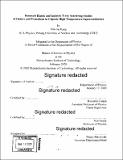| dc.contributor.advisor | Riccardo Comin. | en_US |
| dc.contributor.author | Kang, Min Gu,S.M.Massachusetts Institute of Technology. | en_US |
| dc.contributor.other | Massachusetts Institute of Technology. Department of Physics. | en_US |
| dc.date.accessioned | 2020-10-19T00:42:53Z | |
| dc.date.available | 2020-10-19T00:42:53Z | |
| dc.date.copyright | 2020 | en_US |
| dc.date.issued | 2020 | en_US |
| dc.identifier.uri | https://hdl.handle.net/1721.1/128095 | |
| dc.description | Thesis: S.M., Massachusetts Institute of Technology, Department of Physics, 2020 | en_US |
| dc.description | Cataloged from PDF version of thesis. | en_US |
| dc.description | Includes bibliographical references. | en_US |
| dc.description.abstract | After 30 years of extensive scrutiny from their discovery in 1986, copper oxide high-temperature superconductors remain one of the most enigmatic and captivating platforms for emergent many-body phases in condensed matter physics. Understanding the emergent physics of collective electronic orders and excitations across the cuprate phase diagram is a key to decode the puzzle of high-temperature superconductivity and how it arises from the strongly correlated Mott state. With the advance of soft X-ray instrumentations during the last decade, resonant elastic and inelastic X-ray scattering (REXS and RIXS) have rapidly established as highly sensitive and versatile probes of electronic orders and excitations in quantum materials. Using REXS at the Cu-L₃ resonance, we investigated the evolution of momentum-space topology of charge correlation in electron-doped cuprates T'-(Nd,Pr)₂CuO₄[subscript delta] as a function of carrier doping. | en_US |
| dc.description.abstract | We revealed that, upon doping the parent Mott insulator, charge correlations first emerge in the form of rotationally-symmetric spatial density modulations, which evolve to more conventional long-ranged checkerboard order at higher doping levels. Our charge susceptibility calculations uncover a close link between the topology of charge correlations and the underlying fermiology in electron-doped cuprates and also suggest that the nature of charge correlations changes from locally incoherent charge ripples to a long-ranged broken symmetry state upon carrier doping. Using RIXS, we developed an experimental method to disentangle various electronic excitations in cuprates based on their nature. Our approach is built on the tensorial nature of the RIXS scattering matrix, whose form is imprinted onto the angular dependence of RIXS signal. | en_US |
| dc.description.abstract | Applying this method to prototypical magnetically-ordered and superconducting cuprates T'-(Nd,Pr)₂CuO₄[subscript -][subscript delta] and YBa₂Cu₃O₆.₇₅, we resolved the charge, spin, and orbital character of elastic scattering, (para-)magnon/bimagnon modes, and higher-energy intraband orbital excitations. | en_US |
| dc.description.statementofresponsibility | by Min Gu Kang. | en_US |
| dc.format.extent | 104 pages | en_US |
| dc.language.iso | eng | en_US |
| dc.publisher | Massachusetts Institute of Technology | en_US |
| dc.rights | MIT theses may be protected by copyright. Please reuse MIT thesis content according to the MIT Libraries Permissions Policy, which is available through the URL provided. | en_US |
| dc.rights.uri | http://dspace.mit.edu/handle/1721.1/7582 | en_US |
| dc.subject | Physics. | en_US |
| dc.title | Resonant elastic and inelastic X-ray scattering studies of orders and excitations in cuprate high-temperature superconductors | en_US |
| dc.type | Thesis | en_US |
| dc.description.degree | S.M. | en_US |
| dc.contributor.department | Massachusetts Institute of Technology. Department of Physics | en_US |
| dc.identifier.oclc | 1200203788 | en_US |
| dc.description.collection | S.M. Massachusetts Institute of Technology, Department of Physics | en_US |
| dspace.imported | 2020-10-19T00:42:52Z | en_US |
| mit.thesis.degree | Master | en_US |
| mit.thesis.department | Phys | en_US |
